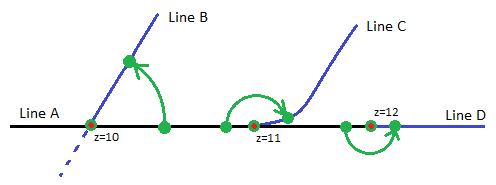Apply a Connector Rule
Connector is an ‘other’ rule used to copy an elevation from one 3D line to another line. To apply it, pick a point on the source line and (like arrow-based rules) a point on the target line. The elevation of the source (from) line is copied to the target (to) line at the intersection/tangent point.
Note: The points created by the rule are just to graphically connect the specified lines to the rule. As shown below, the intersection/tangent point is shown with a red center.

There are several geometric situations in which the Connector rule is helpful. You want to copy the elevation from one line to another where they:
- Intersect as a T or and X shaped intersection (as shown by Line A and Line B above).
- Intersect as tangential approach (as shown by Line A and Line C).
- Intersect in a continuous line (as shown by Line A and Line D).
Using Connector rules versus the Automatic Z-Value property to copy elevations
With a Connector rule, you can explicitly define which line is dominant. The Automatic Z-Value property, in contrast, streamlines work if you have a lot of intersection/touching lines and there is no question from which line the elevation should be derived. In certain cases (e.g., overlapping lines), the Connector rule will give you more accurate results. See Automatically Set Z-Values Where Lines Connect in a Vertical Design for details.
Conflicts with other rules
- The Connector rule does not conflict with any rules.
To apply a Connector rule:
- Pick a point along a 3D line (or enter a Start coordinate).
- Pick a point along the line (or enter an End coordinate).
- Write a Description of the rule.
- To place this rule above the previous, check the Insert above selected rule box.
- Click the Add Rule button.
Properties
- Description - Name given to the rule. When created, it is empty (blank). The name or description can be useful, in some cases, for understanding the order of the rules.
- Type - Connector. This read-only property cannot be edited.
- Source line - Name of first of the two connected lines. If no line is connected, the property is empty (blank). The field is empty if the Hit length is smaller than the distance from the start point to the intersection point with the nearest line (source).
- Target line - Name of the second of the two connected lines. If no line is connected, the property is empty (blank). The field is empty if the Hit length is smaller than the distance from the end point to the intersection point with the nearest line (target).
- Active - When created, this is set to True. If it is True, the rule is used in computations. Set this to False when you want this rule to be ignored.
- Order - Shows the order of the rule in the rules list.
- Status - Shows a code if there is an error computing the rule (or 0 (zero) if the status is okay).
- Message - If the Status=0, this property is blank. Otherwise, there is a message matching the status code.